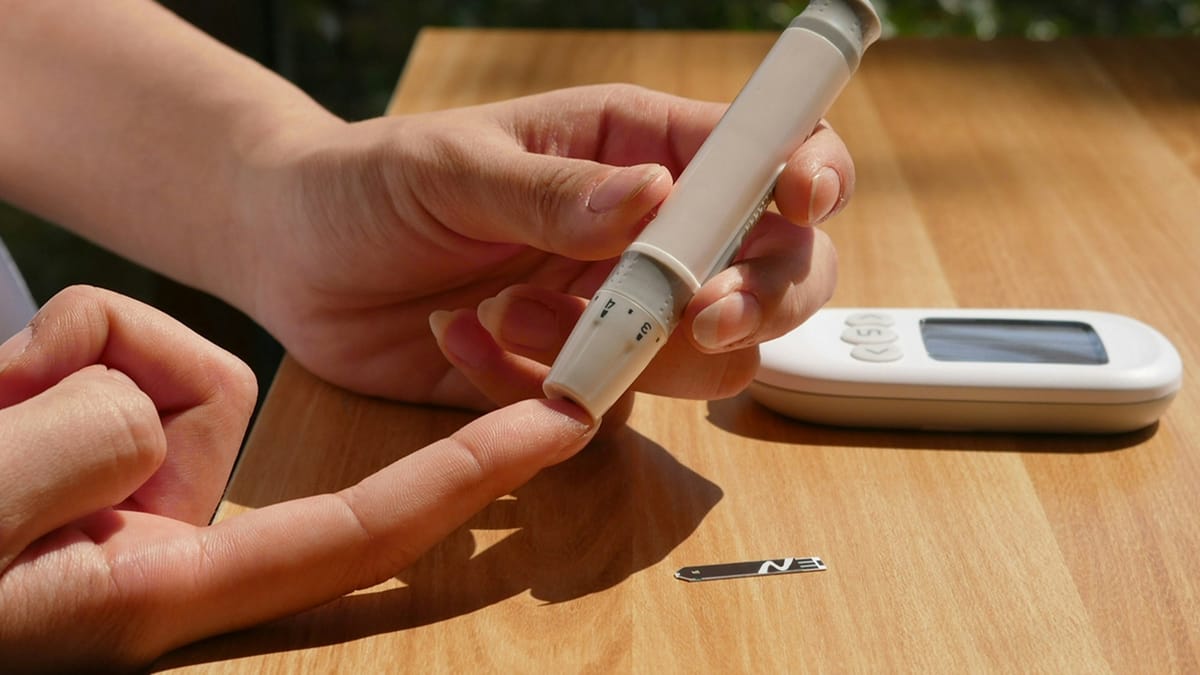Managing Diabetes with Tech: Tools for Better Control
What if managing diabetes could feel less like a constant struggle and more like having a personal health coach in your pocket? With tech tools like CGMs, apps, and telemedicine, taking control has never been easier, let’s explore how.

What if a tiny sensor on your arm or a simple app on your phone could change the way you live with diabetes, making it less about constant worry and more about confidence and freedom?
For millions managing this condition, daily routines of monitoring blood sugar, planning meals, and sticking to treatments can feel like a full-time job. But here’s the good news: technology is stepping in as a powerful ally.
From continuous glucose monitors that track blood sugar around the clock, to apps that log meals and fitness trackers that sync every step, today’s tools are helping people not just survive, but thrive with diabetes. Add in telemedicine, which brings doctors and support directly to your living room, and suddenly, managing diabetes doesn’t have to feel so overwhelming. The future of care is here: smart, connected, and built to put control back in your hands.
Why Technology Matters in Diabetes Care
Living with diabetes isn’t just about a diagnosis, it’s about navigating a daily balancing act of diet, exercise, medication, and constant blood sugar checks. For many, this routine can feel relentless, and the fear of sudden highs or lows adds an invisible weight. This is where technology steps in, not as a replacement for discipline or medical care, but as a partner that makes the journey less overwhelming and more empowering.
Think of technology as a personal health detective, always on the case. Continuous glucose monitors (CGMs), smart insulin pens, and glucose-tracking apps now give patients immediate feedback on their blood sugar levels. Instead of waiting hours, or worse, guessing, people can see what’s happening inside their bodies in real time. This not only reduces anxiety but also helps catch dangerous drops or spikes before they become emergencies.
One of the biggest challenges in diabetes management is sticking to treatment plans. Missed doses, forgotten snacks, or skipped check-ins can quickly throw things off track. Here’s where tech shines: apps send reminders for medication, meal logging makes carb tracking easier, and smart devices sync everything into a neat dashboard. It’s like having a coach in your pocket, keeping you accountable without the nagging.
Diabetes care used to mean constant clinic visits and long waits for lab results. Now, telemedicine bridges the gap. Patients can upload their glucose data from home, and doctors can review trends in real time. Video calls replace some in-person visits, saving time, money, and stress, especially for those living in rural or underserved areas. Perhaps the most underrated gift of health tech is the confidence it gives people. When patients understand their numbers and patterns, they can make smarter choices about meals, exercise, and lifestyle. Instead of feeling like diabetes is running their lives, they gain control. It’s no longer just about survival, it’s about thriving with independence.
Technology isn’t a magic cure, but it’s a powerful equalizer. By breaking down the barriers of complexity, forgetfulness, and access, digital tools are making diabetes care more manageable and personalized than ever before. For some, this means fewer ER visits. For others, it means the freedom to go hiking without constantly worrying about a sudden crash. For all, it means a better quality of life.
Continuous Glucose Monitors (CGMs): A Game-Changer in Diabetes Care
If managing diabetes feels like flying a plane without instruments, then a Continuous Glucose Monitor (CGM) is the dashboard every pilot wishes they had. Instead of finger-pricking several times a day and piecing together scattered numbers, CGMs provide a constant stream of glucose data, painting the full picture of what’s happening inside the body, day and night.
A CGM is a small, discreet device that usually sits on the arm or abdomen. Beneath the skin, a tiny sensor measures glucose levels in the interstitial fluid (the fluid between cells). This sensor sends readings to a receiver, smartphone, or smartwatch, giving real-time updates around the clock. No more guesswork, no more waiting. Just clear, continuous insights.
CGMs don’t just tell you your glucose level, they warn you when things are about to get dangerous. High or low alerts mean patients can act before symptoms set in, preventing emergencies. For parents of children with Type 1 diabetes, or for older adults who may not notice warning signs, this feature is life-changing. Another benefit? Less finger-pricking. While occasional checks may still be needed, CGMs drastically cut down on the pain and hassle of traditional methods. For many, this alone is worth the switch.
Popular options on the market
The tech industry has stepped up big in this space, with several trusted names leading the charge:
- Dexcom – Known for accuracy and seamless smartphone integration.
- Abbott FreeStyle Libre – Easy to use, cost-friendly, and popular worldwide.
- Medtronic Guardian Connect – Offers predictive alerts and integration with insulin pumps.
Each system has unique features, but they all aim for the same goal: more freedom, less stress. Imagine being in an important meeting, and instead of feeling dizzy and panicked, your smartwatch vibrates gently, warning you that your glucose is dropping. Or picture a teenager at a sleepover, whose parents can monitor their levels remotely from home. These aren’t just conveniences; they’re lifelines that improve safety, independence, and quality of life.
At the end of the day, CGMs are more than gadgets. They’re companions that empower people to live fully, whether that means exercising with confidence, traveling without constant fear, or simply enjoying a meal without second-guessing every bite. For many living with diabetes, CGMs represent not just progress, but peace of mind. And when combined with other digital tools, they’re paving the way for a future where managing diabetes feels less like a burden, and more like taking control.
Diet and Exercise Tracking Apps: Your Digital Wellness Partners
When it comes to diabetes, food and movement aren’t just lifestyle choices, they’re medicine. But keeping track of carbs, calories, workouts, and glucose responses can feel like solving a math puzzle every single day. This is where diet and exercise apps step in, transforming that puzzle into a clear, manageable plan. Think of them as digital wellness partners, always ready to log, track, and guide.
Gone are the days of scribbling food notes in a diary or guessing portion sizes. Apps like MyFitnessPal, Carb Manager, and MySugr allow users to quickly log meals, scan barcodes, and calculate carbs automatically. For people with diabetes, this isn’t about calorie obsession, it’s about precision. Tracking carbs means better control of post-meal blood sugar spikes, and having a digital record makes it easier to spot patterns.
Physical activity is just as critical as nutrition in managing blood sugar, and fitness apps bring structure and motivation to daily movement. Whether it’s Fitbit, Apple Watch, or Garmin, these devices sync workouts, steps, and heart rate directly into health dashboards. That means every walk, gym session, or yoga flow can be connected with glucose trends, helping users see in real time how exercise impacts their blood sugar. And it’s not just about movement quantity. Some apps now integrate intensity levels, recovery data, and even stress monitoring, giving a more complete picture of health.
Here’s where things get futuristic. Many modern apps are powered by artificial intelligence that learns from your habits. For example, if your glucose tends to spike after pasta dinners, the app might suggest lower-carb alternatives or recommend a pre-meal walk. These insights make management less about trial-and-error and more about smart, personalized guidance. Tracking doesn’t just provide numbers, it creates accountability. Seeing progress over time, whether it’s steps taken, weight lost, or better glucose averages, fuels motivation. Some apps even gamify the process with streaks, badges, and challenges. Suddenly, managing diabetes feels less like a chore and more like a game you actually want to win.
Imagine a patient with Type 2 diabetes who pairs a diet tracker with telehealth coaching. Over a few months, they see weight drop, energy rise, and A1C improve, without feeling deprived. Or think of a busy parent with Type 1 diabetes using a smartwatch during workouts to prevent sudden drops in glucose. These aren’t just stories, they’re proof of how digital tools can transform everyday life.
Food and exercise are pillars of diabetes care, but they’re also the hardest to manage consistently. With the right apps, patients don’t just track—they learn, adapt, and thrive. Technology doesn’t replace willpower, but it makes the path clearer, easier, and more rewarding.
Telemedicine and Remote Support: Care Without Borders
For decades, managing diabetes meant regular trips to the doctor’s office, long waits for lab results, and limited access to specialists. Today, telemedicine and remote support are rewriting that story. With just a smartphone or computer, people with diabetes can now connect with healthcare providers, share real-time data, and get guidance without ever leaving home. It’s healthcare without borders: fast, convenient, and accessible.
One of the biggest advantages of telemedicine is the ability to share glucose data instantly. Many CGMs and apps allow patients to upload readings to secure platforms, where doctors can review trends and adjust treatment plans in real time. This means fewer surprises and faster interventions. Instead of waiting three months for a follow-up, patients can receive timely feedback within days—or even hours. For busy professionals, parents, or anyone juggling multiple responsibilities, telehealth appointments are a lifesaver. No more rushing to clinics, sitting in waiting rooms, or rearranging schedules. A quick video call during a lunch break can provide the same level of care, minus the hassle. For those with mobility challenges or transportation issues, this convenience can mean the difference between consistent care and missed appointments.
Telemedicine is also breaking down barriers for patients in rural or underserved areas, where access to specialists is limited. Instead of traveling hours for care, they can now connect with endocrinologists, nutritionists, or diabetes educators from their living rooms. This democratization of healthcare ensures that quality support is no longer determined by geography.
Beyond doctor visits, digital platforms also provide coaching, peer groups, and educational programs. Online support groups foster community, where people can share tips and encouragement. Virtual coaching helps with motivation, troubleshooting, and building healthy habits. This ongoing guidance reduces feelings of isolation and reminds patients that they don’t have to navigate diabetes alone. Take, for example, a patient using telemedicine to combine diet tracking with regular video check-ins. Over time, they see improved weight, better A1C results, and more confidence in managing their condition. Or consider older adults using caregiver-monitoring apps, which allow family members to stay updated and intervene quickly if needed. These stories highlight how technology isn’t just convenient, it’s life-changing.
Telemedicine and remote support are not just about replacing clinic visits. They’re about giving people with diabetes more freedom, faster access to care, and stronger support systems. At its core, this is about empowerment: the ability to take charge of health without being limited by time, distance, or circumstance.
Finding Freedom with a Small Sensor
For years, Taylor, a 34-year-old marketing professional with Type 1 diabetes, lived in quiet fear. Meetings, workouts, even dinners with friends carried a hidden weight: What if my blood sugar drops without warning? Taylor carried snacks everywhere, checked glucose levels constantly, and sometimes skipped activities just to stay safe. Life felt more about managing diabetes than actually living.
That changed the day Taylor’s doctor suggested trying a Continuous Glucose Monitor (CGM). At first, it seemed intimidating, another device to figure out, another cost to consider. But within days, Taylor noticed a difference. The CGM sent real-time readings straight to a smartwatch, buzzing gently when glucose started trending low. Suddenly, instead of reacting to symptoms after they appeared, Taylor was two steps ahead.
The impact went beyond numbers. At work, Taylor could focus fully on presentations without the constant worry of “what if.” During workouts, the CGM gave reassurance that blood sugar wouldn’t crash unexpectedly. Even nights became more peaceful, knowing alerts would sound if things went out of range.
Taylor describes it simply: “It feels like I’ve been given back my freedom.”
This story isn’t unique, technology is giving thousands of people with diabetes the chance to live with less fear and more confidence. Tools like CGMs, tracking apps, and telemedicine don’t just monitor glucose; they restore independence, reduce anxiety, and make space for joy in everyday life. Because managing diabetes isn’t just about control, it’s about living fully.
Your Top Questions Answered
1. What is a Continuous Glucose Monitor (CGM), and how does it work?
A Continuous Glucose Monitor (CGM) is a wearable device that tracks your blood glucose levels in real time throughout the day and night. It consists of a small sensor placed under the skin, typically on the abdomen or upper arm, which measures glucose levels in the interstitial fluid. This data is transmitted wirelessly to a receiver or smartphone app, allowing you to monitor your glucose trends and make informed decisions about your diet, exercise, and insulin use.
2. Do I need a prescription to get a CGM?
Traditionally, CGMs required a prescription from a healthcare provider. However, recent advancements have made some CGMs available over-the-counter (OTC). For instance, Dexcom's Stelo and Abbott's Lingo are now FDA-cleared for OTC use, meaning you can purchase them directly without a prescription. It's important to consult with your healthcare provider to determine if an OTC CGM is suitable for your specific needs.
3. How accurate are CGMs compared to traditional fingerstick tests?
While CGMs offer real-time glucose monitoring, they may not always match the accuracy of traditional fingerstick tests, especially during rapid glucose changes or when glucose levels are very high or low. It's recommended to use fingerstick tests to confirm CGM readings when making critical treatment decisions, such as insulin dosing. Regular calibration and proper sensor placement can help improve CGM accuracy.
4. Can CGMs help people with Type 2 diabetes who aren't on insulin?
Yes, CGMs can be beneficial for individuals with Type 2 diabetes, even those not using insulin. They provide valuable insights into how lifestyle factors like diet and exercise affect blood glucose levels. This information can help in making informed decisions to manage blood sugar more effectively. Discuss with your healthcare provider to determine if a CGM is appropriate for your diabetes management plan.
5. Are there any risks associated with using CGMs?
While CGMs are generally safe, some users may experience skin irritation at the sensor insertion site. It's essential to follow proper hygiene practices and rotate sensor sites to minimize discomfort. Additionally, CGMs may not detect rapid changes in blood glucose levels as quickly as fingerstick tests, so it's important to remain vigilant and continue regular monitoring as advised by your healthcare provider.
Key Takeaways
- Technology empowers control: Digital tools like CGMs, apps, and wearables give people real-time insights into blood sugar trends, supporting better daily decisions.
- Continuous monitoring improves safety: CGMs alert users to dangerous glucose highs and lows before symptoms occur, reducing emergency risks.
- Apps simplify tracking: Diet and exercise tracking apps make logging meals, carbs, and workouts easier, helping patients spot patterns and maintain consistency.
- Telemedicine increases accessibility: Virtual visits allow patients to consult healthcare providers without travel, making expert care more convenient and inclusive.
- Personalized guidance is key: AI-driven apps and digital tools offer tailored recommendations based on individual glucose responses and lifestyle habits.
- Integration boosts effectiveness: Syncing wearables, apps, and telemedicine platforms provides a comprehensive view of health, improving overall diabetes management.
- Start small and scale: Begin with one tech tool, such as a CGM or nutrition app, before adding more, to avoid feeling overwhelmed.
- Data trends matter more than single readings: Focus on patterns over time rather than stressing over individual glucose numbers.
- Support systems enhance success: Caregiver monitoring apps, online coaching, and peer communities provide guidance, accountability, and encouragement.
- Tech restores independence and confidence: By providing actionable insights and reducing anxiety, technology helps patients live fuller, more empowered lives.
Conclusion
Living with diabetes can feel like walking a tightrope, constant monitoring, careful meal planning, and managing medication can easily become overwhelming. But the landscape of diabetes care is changing, and technology is at the forefront of that transformation. Tools like continuous glucose monitors, diet and exercise apps, fitness wearables, and telemedicine platforms are not just gadgets, they are powerful allies that give patients real-time insights, actionable guidance, and peace of mind.
By integrating these tools into daily life, people with diabetes can make informed decisions, anticipate glucose fluctuations, and maintain healthier routines with less stress. CGMs provide a continuous window into blood sugar trends, apps simplify tracking, and telehealth ensures ongoing connection with healthcare providers, no matter where patients are. Together, these innovations shift diabetes management from reactive to proactive, helping individuals regain independence and confidence.
Embracing technology doesn’t replace medical care or discipline, but it amplifies it. It allows patients to live more fully, reduce anxiety, and focus on the moments that matter rather than the numbers. The future of diabetes care is here, smart, connected, and empowering, and it’s ready to put control back in your hands.
References
https://stanmed.stanford.edu/ai-tool-manage-diabetes-smart-speaker/
https://pubmed.ncbi.nlm.nih.gov/38842632/
https://pubmed.ncbi.nlm.nih.gov/40338639/
https://pubmed.ncbi.nlm.nih.gov/40590663/
https://www.yalemedicine.org/news/continuous-glucose-monitor
https://my.clevelandclinic.org/health/articles/continuous-glucose-monitoring-cgm
https://pubmed.ncbi.nlm.nih.gov/39998918/
https://academic.oup.com/jcem/article/110/Supplement_2/S165/8042156
https://pmc.ncbi.nlm.nih.gov/articles/PMC3746288/
This article was written by Lucía Romero Lastra, a seasoned writer and editor with expertise in crafting engaging and informative articles




